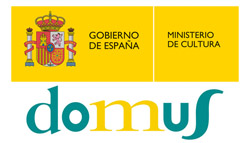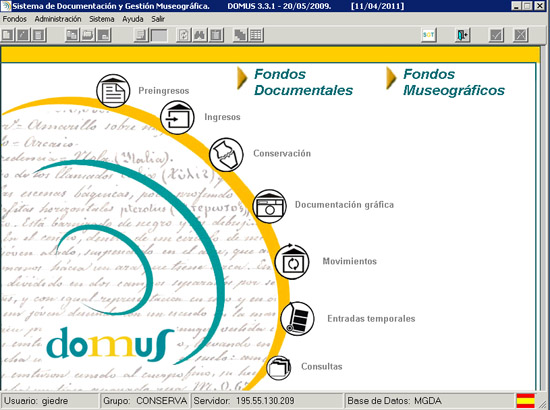A Look at the Spanish Museums: an Integrated Documentation and Museum Management System DOMUS
For almost a decade Spanish museums have been using DOMUS, an integrated collections documentation and museum management system. Triggered by the new technological challenges and aiming for the modernisation of museums and their management, in 1996 the Spanish Ministry of Culture initiated the development of the system. It is obvious today that the direction towards an integrated museum system that cultural policy makers took was, indeed, far-sighted; at this moment, there are more than 150 museums that use DOMUS for their collections documentation and promotion.
The  Ministry of Culture not only initiated the development of an integrated museum system but also devised a specification for it. Published in 1996 as “Museum Documentation Standardisation”, it proposed an assemblage of museum procedures that should be documented, i.e. the acquisition of exhibits, tracking of exhibits moving to other locations, temporary storage, conservation, as well as the requirements for descriptive and cataloguing procedures, thesauruses, etc. DOMUS application was first installed in 1999 after three years of hard work. The first museum to test the system was the National Museum of Anthropology where the pilot project was undertaken. In 2000-2002 DOMUS was introduced at the seventeen state museums. Each museum has a server to store data and an administrator to maintain the system; backups of data are being kept.
Ministry of Culture not only initiated the development of an integrated museum system but also devised a specification for it. Published in 1996 as “Museum Documentation Standardisation”, it proposed an assemblage of museum procedures that should be documented, i.e. the acquisition of exhibits, tracking of exhibits moving to other locations, temporary storage, conservation, as well as the requirements for descriptive and cataloguing procedures, thesauruses, etc. DOMUS application was first installed in 1999 after three years of hard work. The first museum to test the system was the National Museum of Anthropology where the pilot project was undertaken. In 2000-2002 DOMUS was introduced at the seventeen state museums. Each museum has a server to store data and an administrator to maintain the system; backups of data are being kept.

An Integrated Documentation and Museum Management System DOMUS
The owner of the system is the Ministry of Culture; it has an annual agreement with a private company which is directly responsible for the maintenance and updating of the system as well as repairing failures and making backups of data. These tasks could be performed in several ways: via phone, visiting museums that have DOMUS servers installed or managing the incidents by online task manager.
From 2002 the Ministry has been signing agreements with regional governments and city councils regarding the use of DOMUS in different autonomous communities and cities in Spain. Hereby the coordination of DOMUS is delegated from the Ministry of Culture to regional administrational units.
Some regions do not contribute much to the development of DOMUS; the examples of the museums of Aragon and Andalucía, however, do prove that the system is necessary for all types of museums and helps to effectively manage and document the collections. The agreement on the installation of DOMUS system between the Government of Aragon and the Ministry of Culture was signed in 2004. First the system was being installed in the museums that are under the jurisdiction of Aragon Government, and from 2007 – in other museums (i.e. operated by provinces, municipalities, churches, and public foundations) as well. The autonomous region of Aragon was the first to use DOMUS to document the collections of Church museums as well as to catalogue the heritage of the history of education held at the educational institutions (gymnasiums and university).
According to valid laws, museums are under no obligation to use integrated system and digitise exhibits; this notwithstanding, both national and regional governments encourage museums to do so. Made using taxpayers’ money, a cost-free DOMUS system is the handiest tool for collections documentation as well as for data relating and publishing on the international portals, such as “Europeana”. The only condition that the Ministry of Culture has imposed upon the use of DOMUS is that the exhibits catalogues made on the system would be accessible on the internet (e.g. the online catalogue of the collections of Spanish museums CERES available on and on Spanish cultural heritage repository “Hispana”). The reason behind that is clear: the ministry financed the development and maintenance of the system as well as the acquisition of all necessary technical equipment and the training of museum specialists. The benefits of DOMUS should thus be enjoyed by the society and be easily accessible on the internet so that every citizen could admire country’s cultural values.
Text prepared by Giedrė Stankevičiūtė
according to the information obtained during the internship at the Department of Education, Culture and Sports of the Government of Aragon
For more information read Giedrė Stankevičiūtė’s review „A Look at the Spanish Museums: Dissemination of Digital Cultural Heritage„






